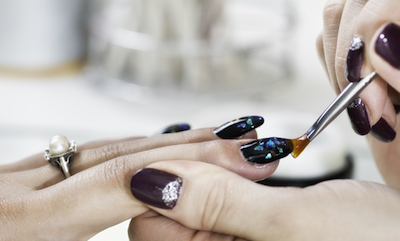Nail Technicians’ Blood Shows Elevated Chemical Levels.
 Last year, the Boston Public Health Commission (BPHC) implemented new requirements for active ventilation at nail salons. Now, the first study of harmful volatile organic compounds (VOCs) in nail technicians, led by School of Public Health researchers, finds elevated blood levels of toluene and ethyl acetate, but that better ventilation reduces the levels of these compounds in the air that the workers breathe.
Last year, the Boston Public Health Commission (BPHC) implemented new requirements for active ventilation at nail salons. Now, the first study of harmful volatile organic compounds (VOCs) in nail technicians, led by School of Public Health researchers, finds elevated blood levels of toluene and ethyl acetate, but that better ventilation reduces the levels of these compounds in the air that the workers breathe.
The study, published in the journal Indoor Air, uses data collected before the BPHC requirement went into effect.
“Our findings further justify the BPHC’s decision to require better ventilation in all nail salons in the City of Boston to protect the health of nail technicians,” says lead author Diana Ceballos, assistant professor of environmental health. “There is much we still need to know about safer nail products, use of personal protective equipment, and other measures to further protect nail technicians from these chemicals.”
Ceballos notes that many nail product brands are eliminating toluene—which can cause eye, respiratory, and skin irritation, as well as nervous-system dysfunction and developmental impairment through extended exposure—from their formulas, and California regulators are working to ban the chemical in nail products outright. Ethyl acetate is still found in most nail polishes and many other nail products, and is associated with eye, skin, nose, and throat irritation, as well as nervous system depression, liver and kidney swelling, corneal clouding, and anemia.
For the study, Ceballos and her colleagues assessed VOC exposure in 10 full-time, non-smoking, female nail technicians from seven Greater Boston salons over one work day. The researchers collected blood samples from each nail technician before and after her shift, tested ventilation, observed her work practices and the products that she used, and clipped a “personal air” sampling tube to her breast pocket throughout the shift to continuously monitor the air she was breathing.
Of the VOCs detected, the highest levels were for toluene and ethyl acetate, with the levels of both significantly increasing from start to end of shift. Levels found in both air and blood were well below occupational guidelines set for these chemicals, but Ceballos says these kinds of guidelines are generally based on acute health effects such as skin and eye irritation or spontaneous abortion, not chronic effects from prolonged exposure such as many other reproductive health issues.
The authors also noted that, based on the levels of VOCs detected in the air in these salons before the BPHC began requiring ventilation systems that move air outdoors, nail salons may now be putting unhealthy levels of these chemicals into the outside air, warranting further study.
The study’s senior author was Thomas Webster, professor of environmental health, and the study was co-authored by environmental health doctoral students Jessica Craig, Victoria Fruh, and Zoe Petropoulos.
The other co-authors were: Xianqiang Fu and Chunrong Jia of the University of Memphis School of Public Health; David Chambers, Alai T. Fernandez, and Lydia Thornburg of the Volatile Organic Compounds Laboratory in the Tobacco and Volatiles Branch of the Centers for Disease Control and Prevention; and MyDzung T. Chu, Joseph G. Allen, and Jose Vallarino of the Harvard T.H. Chan School of Public Health.